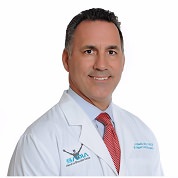Hand and Upper Limb Orthopedic surgeon Dr. Alejandro Badia with tips on this increasingly popular way to seek medical care and how it works for wrist, hand, finger, elbow or shoulder conditions.
MIAMI (PRWEB) January 08, 2019
Ever use Skype or other videoconferencing technology to “see” people virtually while you speak with them from afar? That’s precisely the way telemedicine visits work, which can be an excellent way to receive care for hand and upper limb conditions, according to hand and upper limb orthopedic surgeon Alejandro Badia, MD, founder of Badia Hand to Shoulder Center and OrthoNOW, a network of walk-in orthopedic care clinics.
With increasingly universal access to computers and smart phone technologies and devices, telemedicine has exploded over the past decade and is used in many specialties, ranging from internal medicine to stroke care to dermatology to orthopedics and more. For doctors, this makes it easier to view patients’ electronic medical records as well as digital test results and images. But for patients, virtual office visits seem to have made the biggest impact, says Dr. Badia.
“Telemedicine is a highly effective method of assessing and managing patients remotely, saving them time both in travel and taking off work,” says Dr. Badia. “Once I explain to my patients how we can use telemedicine to help diagnose and treat their hand or upper limb condition more convenient for them without sacrificing quality of care, most of them are happy to take part.”
How telemedicine works:
What are the steps to accessing a telemedicine office visit? In Dr. Badia’s practice, for example, it’s a very straightforward process – which is typically the case with other types of specialists who offer telemedicine options, he says.
First, a patient can request a telemedicine e-visit, a request that can be made online. Patients enter their location in the United States – or even internationally – and the types of symptoms and problems they’re experiencing with their hand, fingers, wrist, elbow and/or shoulder. Patients may be asked to send along medical records electronically, including x-rays, MRIs or other images previously done and any necessary supportive information that helps the doctor better understand their case.
Then, Dr. Badia meets with a patient via Zoom Health – a particular brand of communications software, though other types of software may also be used in telemedicine – to assess the patient’s situation and determine next steps. Some doctors do these telemedicine assessments with the help of a nurse or other clinician, who can walk the patient through various physical tests to enhance the doctor’s understanding of a case, Dr. Badia notes.
“Some conditions will require an in-person office visit, depending on their seriousness or complexity,” Dr. Badia says, “but for many patients it’s easy to do follow-up care strictly through telemedicine.”
Benefits of telemedicine:
Why would you use telemedicine instead of – or in addition to – traditional care? The benefits are clear and numerous, Dr. Badia explains. They include:
- Cost: Both patients and doctors stand to lose money with typical in-office care, but telemedicine can cut costs. “Patients often spend hours – between travel time and lost work time – driving to and from doctor’s appointments, not to mention the appointment time itself,” Dr. Badia notes. “And doctors can lose money on cancellations or no-shows. Telemedicine is a win-win from a cost standpoint.”
- Convenience: Don’t forget that taking time off work or school to go to the doctor can be a huge hassle, not to mention traffic or other obstacles to getting to a brick-and-mortar facility. “Telemedicine lets patients stay in their homes or offices and get high-quality care without the inconvenience,” Dr. Badia says. “In some states, even prescriptions can be sent immediately to a pharmacy after a telemedicine visit. Talk about convenience!”
- Saves Time: Particularly for those with chronic health conditions, who may need to check in with their doctors frequently, telemedicine visits save untold hours, Dr. Badia says. And many conditions require only quick visits to renew a prescription, so a long commute seems wasteful. “Time and convenience are intricately wrapped together, and time is also money,” he says, “so this is perhaps the biggest benefit of all.”
Check with your doctor if telemedicine visits – which can be influenced by various state regulations – are an option, Dr. Badia says.
Dr. Badia also notes that telemedicine has been so successful in his practice, that the OrthoNOW team is now implementing this in their OrthoNOW centers via a service called OrthoLIVE. Patients can inquire about less severe orthopedic issues or have follow up visits in this manner, but referring entities, whether primary care doctors, athletic trainers or employer health clinics, can all instantly reach an orthopedic clinician for questions and remote assessment followed by ordering the appropriate diagnostic study including x-ray when needed.
“For a fraction of the cost typically incurred in traveling expenses, you can request an appointment for a virtual initial consultation, second opinion and quick follow-up visits right from the convenience of your home or office,” he adds. “I urge anyone who is reluctant to just give it a try. Telemedicine is one of the best things to emerge from our recent advances in technology.”
Bio: Alejandro Badia, MD, FACS, internationally renowned hand and upper-limb surgeon and founder of Badia Hand to Shoulder Center and OrthoNOW®, a walk-in orthopedic care clinic. He is a member the American Society for Surgery of the Hand, American Association for Hand Surgery and the American Academy of Orthopedic Surgeons. He is a specialist in treating all problems related to the hand and upper extremity including trauma, sports injury, joint reconstruction, nerve injuries and arthroscopic surgeries. http://www.drbadia.com

